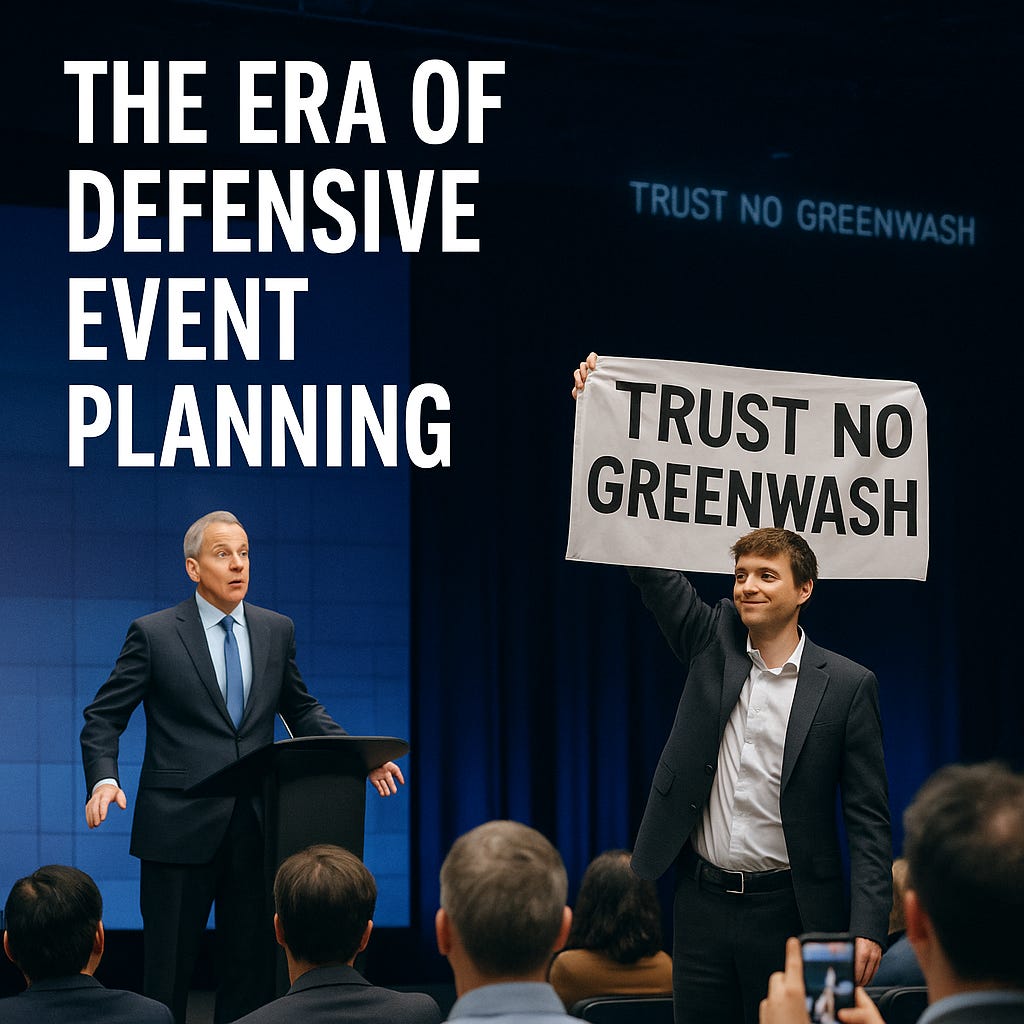Inside the Protest That Stole Your Event
How Climate Defiance’s stagecraft collided with corporate crisis choreography—and what happens when both sides rehearse for the same moment.
Editor’s Note:The battle for the modern stage isn’t about spotlights or sponsors anymore. It’s between those who rehearse disruption—and those who rehearse composure. In this story, David Adler traces how Climate Defiance and corporate America have become mirror images of each other, each planning the same moment from opposite sides of the aisle.
The conference hall was calibrated to perfection. LED panels washed the stage in the exact shade of optimism. Sponsor logos aligned like constellations. The keynote speaker stepped forward, cycling through the language of the age—regenerative futures, sustainable growth, investment in nature.
Then came the fracture.
A figure stood up in the third row. A banner unfurled. A drone rose. And on the ceiling, in pale defiance: TRUST NO GREENWASH. The presenter froze. The emcee hesitated. Within seconds, the story the hosts had scripted slipped out of their control.
What followed wasn’t just a protest. It was a hijacking of emotional momentum. Applause faded into silence. Anticipation twisted into anxiety. The psychological temperature flipped—a textbook case of emotional contagion. The audience wasn’t reacting to facts. They were reacting to dissonance.
The hijacking had a name: Climate Defiance—part protest group, part production company—founded in 2023 by Michael Greenberg and Rylee Haught. Their mission: force climate urgency into the public square, through nonviolent, unforgettable moments.
Polite lobbying was out. Stagecraft was in.
At the New York Times’ Climate Forward, Occidental Petroleum’s CEO had barely begun before the disruption unfolded. Ten arrests later, the event went virtual—but the footage had already gone viral. At the DNC’s winter meeting, a three-story banner screamed: Oil $$$ Out of the DNC. In the Hamptons, amid wildfire haze, they disrupted EPA chief Lee Zeldin. The chant? “What will you tell your children when the Hamptons are underwater?”
Michael Greenberg doesn’t fit the caricature of a radical. Willowy, soft-spoken, with a stand-up comic’s timing and a physician’s son’s precision. “Stand-up teaches you how to read a crowd,” he told me. “You sense energy. You break tension. Protesting isn’t that different—it’s a live audience, and you’re trying to change how they feel.”
When he isn’t organizing, he plays ultimate frisbee or drops into open mics to keep his timing sharp. “Comedy’s just another way of processing fear,” he says. “I just found a bigger stage.”
His team operates like a startup. Their Slack channels resemble a campaign war room: #visuals, #rapidresponse, #legalbriefs. Their playbook is practically public—a decentralized action manual. Only a few know the full plan; others get fragments. Timing is everything. Phones are locked. Jail-support numbers are scrawled on forearms. Videographers are trained like war correspondents: hold frame, upload fast, beat the official feed.

 Tiktok failed to load.
Tiktok failed to load.Enable 3rd party cookies or use another browser
One now-viral TikTok clip captures it perfectly: watch here. Greenberg enters a small meeting warm, curious, like any other attendee. He listens. Smiles. Speaks. Then turns. In one calibrated phrase, the emotional temperature flips. It’s not just disruption. It’s infiltration by charm.
“You don’t need to shout if they already said yes to listening,” Greenberg told me. “People let their guard down around warmth.”
They study Extinction Rebellion, ACT UP, The Yes Men. But their edge is tone—controlled, strategic, almost gentle… until it’s not. The result: disruptions that feel theatrical, not chaotic. Moments that are meme-ready, not messy. As one organizer put it: “It’s immersive theater meets moral indictment.”
But they’re not the only ones rehearsing.
On the other side of the aisle, event planners have developed a new genre of production: defensive design.
At major summits, moderators are now trained not just to redirect but to stabilize. “Let’s hold this moment. Let’s stay in this room together.” is as rehearsed as any keynote.
One elite producer showed us their scenario tree: Banner drop? Emcee steps forward with empathy. Protest chant? Acknowledge, redirect. Drone appears? Cue ambient lighting and pivot to video. What used to be called “crisis comms” has become emotional stagecraft.
Some events now feature:
Emotional anchoring: Opening with personal grounding to build loyalty before disruption.
Micro-audience mapping: Preemptively scanning the room for potential flashpoints.
Sentiment spotters: Social listening teams monitoring live emotional shifts.
Atmospheric dampening: Using lighting or music to de-escalate without confrontation.
Former protestors are even being hired as consultants—designing against their own tactics.
For controversial sectors—oil, pharma, defense—the strategies go even further.
They now deploy:
Parallel programming: High-risk content is siloed in invite-only breakout rooms.
Narrative insurance: Counter-stories are prewritten, ready to flood the feed: “Why Disruption Means We’re Winning.”
Feed flooding: Authentic-looking clips staged in advance to outperform protest content.
Decoy moments: Celebrity appearances or product reveals to overshadow protest timing.
One key architect of this shift is David Fuscus, CEO of Xenophon Strategies and founder of Précis AI. Fuscus has handled crises from plane crashes to pharma lawsuits. Now he monitors protests before they happen.
“There are two kinds of companies,” he said. “Those that have had a crisis. And those that will. Speed is everything.”
His AI platform doesn’t replace judgment—it buys time. At a recent event, three protestors were found hiding in a supply closet. “Security wanted to arrest them,” he said. “I told them: give them sandwiches. Walk them out. Don’t feed their narrative with a perp walk.”
We’ve entered a new arms race—not of power, but of poise.
Behind the curtain, this choreography is often shaped by the big-name firms who’ve defined modern crisis response: Brunswick, Edelman, APCO Worldwide, Hill+Knowlton Strategies, Sitrick And Company, Teneo, Rokk Solutions, FTI Consulting, SKDK, BerlinRosen, The Messina Group, and Kekst CNC. Once mostly invisible to audiences, they’re now being called in before a stage is even built—drafting scenario trees, preloading messaging, and prepping spokespeople not just for what they say, but how they recover when the message collapses in real time.
Some have even embedded AI tools into their war rooms, forecasting narrative volatility like weather systems. Protesters rehearse empathy as a Trojan horse. Event organizers rehearse compassion as containment.
The stage is no longer neutral. It’s a contest of choreography. Of who owns the moment when the script breaks.
The protest doesn’t have to win. It just has to hijack the story.
And in this new era of events, perfection isn’t what happens on stage—it’s what you do when the stage is no longer yours.





